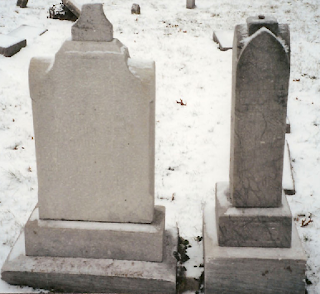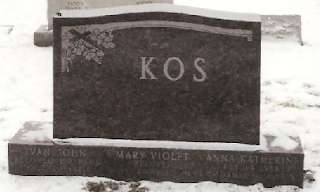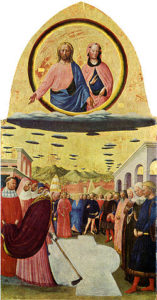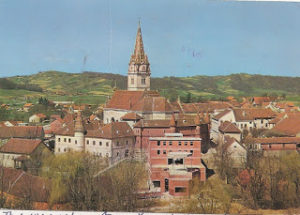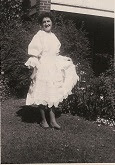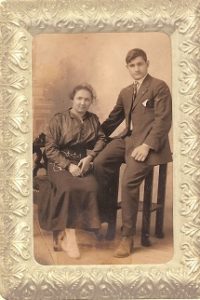Originally published on genealogyatheart.blogspot.com on 22 Jul 2015.
It was the Great Depression and times were tough as my grandfather, Gramps, had his work hours reduced at the steel mill. The family took in boarders but as their hours were also cut, money was extremely tight. One of our family legends takes place in the midst of this difficult period.
Gramps always turned his paycheck over to my grandmother, Non, to cash. The family had an account at Gary National Bank on Broadway in Gary, Indiana. The typical routine was Non would cash the check, put a small amount in savings and then on her way home, shop for groceries at a small family run store. One never knows when a typical day will turn into a major event but that was what was about to happen.
Non stood in line at the bank awaiting her turn with the teller. Hearing noise, she turned and saw a group of men exiting a car parked at the curb. What made the scene different was they were waving guns and had their hats pulled down low over their eyes. Bursting into the bank, the ring leader ordered everyone to get down on the floor. Non stood still, in shock, clutching Gramps’ check. Shots were fired at the ceiling. Non continued to stand still. As one gunman approached the tellers directing them to place money in the bag he carried, another stood guard at the door. A third man approached Non and again ordered her to get down on the floor. Non pleaded, “Please, sir, my husband is a cripple and I have 3 small children. My widowed mother and my sister also live with me. I need this money. Please don’t take it.” The gunman replied, “Get down now or I’ll shoot.” Non got down on the floor. “Put your hands out to the side.” he ordered. Non complied.
Minutes later the gunman was back and he dropped a stack of bills in Non’s outstretched hand. She turned her head and saw him wink at her. The gunmen told the customers to remain on the ground until they counted to 100 aloud. Departing, the robbery was over.
When they got to 75 Non shoved the bills down the top of her dress. Amply endowed, no one would notice. Non not only could use the money, she feared that the police would think she was an accomplice if she reported what had happened so she said nothing.
After Non got home she hid the money, which amounted to several hundred dollars, fearful that if she used it she would be in trouble. Years later, after the robbers were convicted, the money was used to partly pay for the family home being bricked. Non swore that the gunman who gave her the money was John Dillinger, the Indiana farm boy turned bank robber.
Problem is, Dillinger didn’t rob a Gary National Bank. He robbed a 1st National Bank in East Chicago, Indiana1 but Non would not have gone that far as she would have had to rely on street cars to get there nor was that bank located on Broadway.
Historians dispute some of the bank robberies at the time that were thought to be committed by Dillinger. A friend of Dillinger’s, John “Red” Hamilton and Baby Face Nelson’s gang has now been credited with some of the robberies initially attributed to Dillinger. Today, 14 robberies are thought to have been the work of Dillinger between 1933-1934.2
Non insisted that Dillinger was the man who gave her the money. There are many reports of Dillinger’s compassion. “Dillinger was generous with his ill-gotten gains, leaving $100 bills behind for each member of the family whenever he visited and one time offering to finance Gallagher’s (his niece’s) dream of opening a beauty shop by giving her $5,000. After discussion by the family, it was decided not to accept the money.”3 Another “story told of a farmer who had come to a bank to make a deposit while the gang was robbing the place. Standing at the teller window with his money in front of him, Dillinger asked the farmer if the money was his or the bank’s. The farmer answered it was his and Dillinger told him, “Keep it. We only want the banks’.”4
Was Dillinger involved in the robbery Non remembered or not? Possibly his role was that of an accomplice and not the leader. Perhaps Non was mistaken and the robber was not Dillinger.
There were several bank robberies so I can’t pinpoint which robbery Non experienced. I can understand as an immigrant with a previous arrest (see The KKK Strikes post of 18 July 2015) she would fear further police involvement. Although I can understand why Non didn’t tell authorities about the money she received it clearly was wrong. In genealogy, separating our family’s past choices from our present lives can be difficult. Keeping in mind that we’re all imperfect humans helps.
 |
| Mary & Daughter Mary Lou Before Bricking 1943 |
1 “John Dillinger – List of His Bank Robberies.” AwesomeStories.com. N.p., n.d. Web. 08 July 2015.
2 Ibid
3 “Dillinger Relatives to Attend New Museum Opening.” Nwitimes.com. N.p., 28 Feb. 2015. Web. 08 July 2015.
4 “John Dillinger.” History.com. A&E Television Networks, n.d. Web. 08 July 2015.







